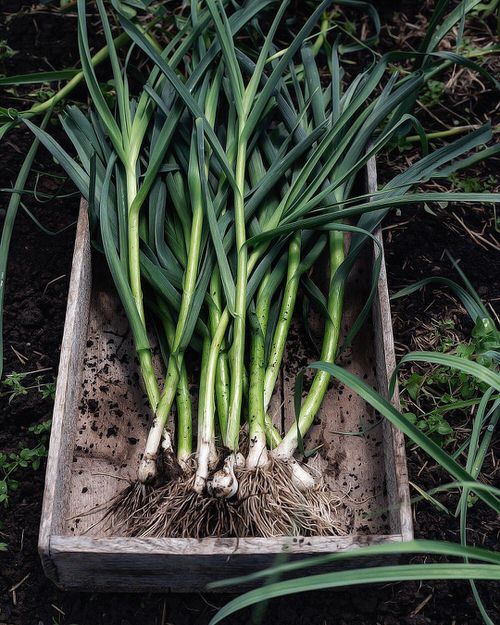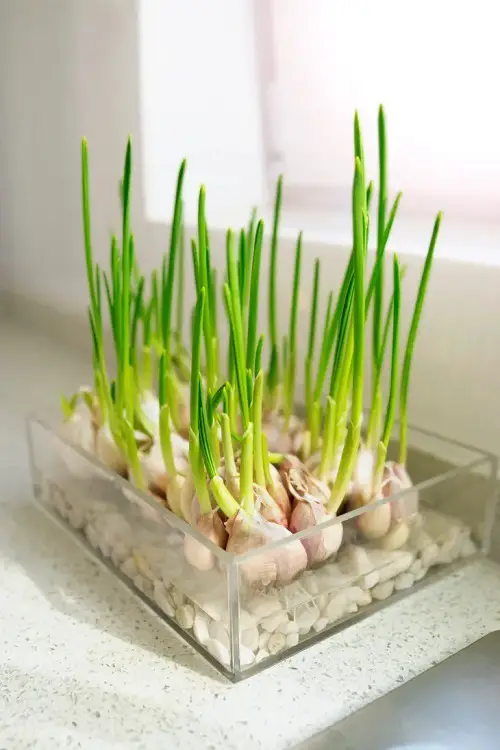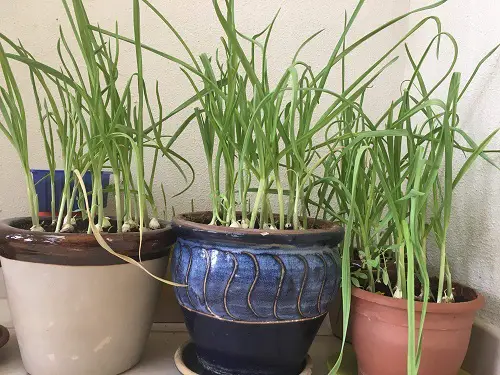Just like green onions, learn How to Grow Garlic Greens in containers on your balcony or indoors to get a year-round supply.

Garlic greens are one of the most versatile vegetables and can be used in many ways: from garnishing soups to salads for a mild & sweet garlic-y taste. It tastes similar to green onions and has an amazing flavor, whether you savor it raw or cooked. Read on to learn How to Grow Garlic Greens easily!
Check out how to grow garlic indoors here
What Are Garlic Greens?
Garlic greens, also known as Springs and Baby Garlic, are young garlic plants with delicate leaves resembling scallions. Their shoots are harvested before the bulb forms. If garlic cloves are way too strong for you can replace them with garlic greens for a more milder flavor.
Check out some surprising uses of garlic in the kitchen here!
Are Garlic Greens and Garlic Scapes the Same Thing?
No, they’re different! Garlic green is tender garlic with soft leaves. It is harvested before the bulb is formed. Garlic scapes, on the other hand, are formed later in the season with curly shoots, having a bud on the top, and tightly closed.
When to Plant Garlic Greens?

When it comes to growing garlic greens in pots, there is no condition for planting time. Since you’re growing it in a pot, and that too, indoors, you can grow it all year round from spring to fall and even in winter with some care, just like green onions.
Learn how to grow Green Onions here
Choosing a Pot
Take a pot around 6-8 inches deep, minimum, and as wide as you want with adequate drainage holes. Maintain 2 inches of spacing between each clove while planting; they wouldn’t mind growing more closely as you’re growing them for greens.
Planting Garlic Greens
You can easily grow garlic greens indoors or outdoors from garlic cloves you already have in your kitchen. For the best result, you can buy cloves from a local farmer or get organic garlic bulbs from your nearest gardening store.
- Fill the pot with a commercial potting mix or a DIY one. You can also mix compost or aged manure in it to make it rich.
- Make 2-3 inches deep holes and insert the cloves, root side facing down, and pointed part up. Ensure that there’s a minimum of one inch of soil on the top of the cloves.
- Maintain 2 inches of space between each clove in the container.
Learn a special trick to root garlic quickly here
How to Grow Garlic Greens?

Location
Place the container near the south or west-facing window, where it receives at least 4 hours of direct sunlight. You can also use indoor grow lights if you don’t have access to that much direct light.
If you have a porch or balcony, much better–keep the pot there.
Water
Watering depends on how much sunlight the plant is getting. Water the plants regularly to ensure the soil is not drying out. If they have enough sunlight exposure, you have to be a little more generous with the watering and do it more frequently as the pots might dry out soon.
Fertilizer
Use an organic, general-purpose fertilizer twice a month during the warm growing season to ensure the proper growth of garlic greens. Alternatively, you can also use fish or kelp meal fertilizer to provide optimum nutrients.
Topping the container with rich compost also works; you can also fertilize with these natural fertilizers suggested here.
Pest and Diseases
Garlic is used as a repellent for several flying and crawling insects, but still there are some pests that bother it. You may see some common pests like aphids, mites, and thrips. If you notice any of these pests, handpick them or use insecticidal soap. You can also use neem oil, it’s natural and safe!
Harvesting Garlic Greens
Within 1 to 2 weeks after planting, you’ll notice green shoots appearing. Start picking them when they’re dense and anywhere between 8 to 15 inches high. Trim the greens with scissors but leave about one inch of shoots above the soil line so their growth will continue. This way, you’ll be able to re-harvest them again.
Use them the way you use green onions and chives–Garnish your pasta, salads, and soups, finely chop them to add in scrambled eggs and omelets, or make Italian-style creamy spring garlic risotto. It can also be an ingredient in chutneys, vegetable fritters, and curries.



Hello, extremely fascinating article. My sister and I have been looking to find thorough tips about this type of stuff for a time, yet we could not until now. Do you consider you can create several youtube videos concerning this, I do believe your web blog will be far more thorough if you ever did. In any other case, oh well. I’m going to be checking on this web-site within the forseeable future. Email me to maintain me up to date.